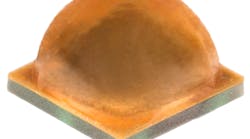Luminus manufactures very-high-power LEDs based on large-area chips with areas in the range of 4-18 mm2. The license will allow Forepi to produce mid-power small-size chips, where "small" by Luminus' definition actually refers to a maximum chip area of around 1mm2 i.e. the de facto industry size for "power" LED chips.
“We chose to license PhlatLight technology because it provides the highest-efficiency chip design in the industry for all chip sizes,” said Frank Chien, president and CEO of Forepi. “We look forward to growing our business by using PhlatLight technology in small and mid-power blue and green LEDs.”
Luminus, which closed a $19 million funding round last month, has focused on large-area (“big-chip”) LEDs based on until now, as Alexei Erchak, the company’s CTO, explains.
“Luminus has been granted more than 40 patents for our PhlatLight technology with over 100 more applications on file,” says Erchak. “Although our primary business remains manufacturing big-chip LEDs, we are pleased that through licensing these patents we can help solid-state lighting grow even faster in small-chip applications.”
Erchak explains that Luminus intends to focus on growing its manufacturing capacity and increasing yield for large-area chips. "However, at this time, it makes sense for us to monetize our IP through licensing," he says. "The 1mm2 chip size is better for companies that already have manufacturing scale."
The license with Forepi is non-exclusive and only includes chip technology, not packaging technology, although Erchak says that Luminus has had lots of enquiries. Predictably, he says there is little likelihood that Luminus would license its technology for large-area chips.
Erchak says there is growing demand for large-area chips, and the company's business is split roughly 50:50 between projection and lighting. "Large-area chips are ideal where you want to collect and place the light, for directional applications or where you want to perform beam-shaping," he says. "Often it can be an aesthetic choice of a single LED over an array."
For replacement lamps, Luminus has a 5mm2 LED that produces enough lumens from a single source to be used in replacement lamps, says Erchak, adding that the company's products are now starting to appear in a number of different lighting applications. "The investment [in technology and manufacturing] is finally starting to pay off," he says.




